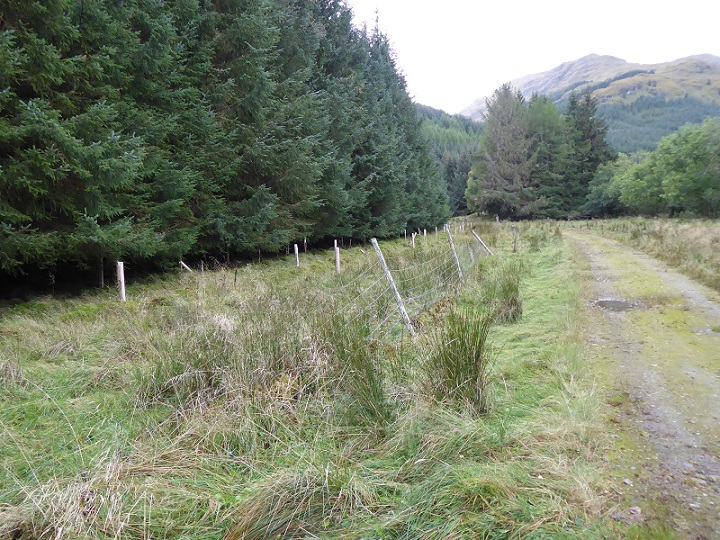
Following my post on the riparian planting in Balquhidder (see here) this photo, taken within ten minutes walk of Inverlochlarig car park, illustrates two key things that are wrong with Scottish forestry practices. It happens to be in Balquhidder and on the Blaircreich Forest Estate, run by the Economic Forestry Group, but in truth could be almost anywhere in Scotland. This post considers the treeless strip of land between the forest and the fence, the hard plantation edge, the state of the fence and the plastic tree tubes
If deer fencing kept out grazing animals for any length of time, one would expect self-seeded trees, free from browsing mouths, to become established along the strips of land that normally surround plantations. While the density of other vegetation, such as grasses and rushes, plays a role in determining how easily trees get established, no grassland will remain as such without help from hungry mouths.
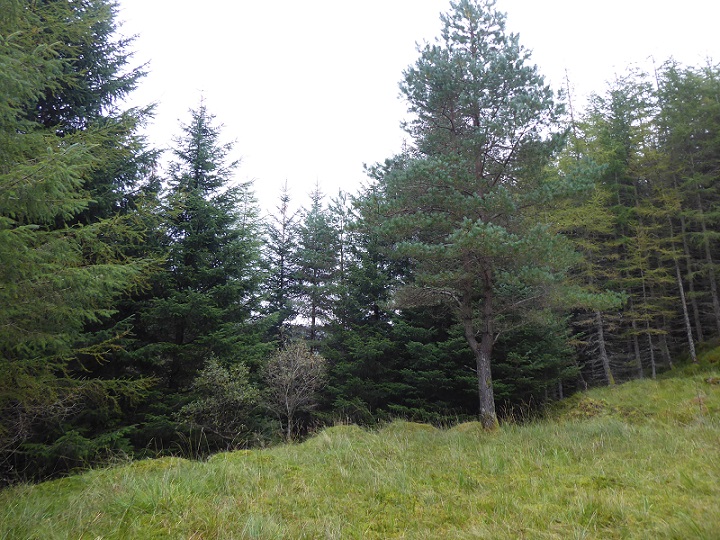
Natural regeneration of trees, whether native species or not, is not a common sight within plantations in Scotland. That is as true of native woodland schemes as it is of conifer plantations. Where you do see such trees, usually they have seeded in the first few years of a plantation’s existence when fences are still intact. Once the main trees crop is established, however, and the trees large enough to resist browsing pressure, maintenance of fences ceases. Deer then get in and the only naturally regenerated trees that survive are those that have grown tall enough to escape the browsing mouths. The smaller seedlings disappear into stomachs.
A consequence of this is that most forestry plantations in Scotland have hard edges which has attracted public criticism because of the visual impact, an unnatural looking line across the landscape. The forest industry has then in some cases tried to respond to this criticism by creating plantations with wavy edges. This would be totally unnecessary if forest fences worked for any appreciable period of time or alternatively deer numbers were properly controlled (i.e reduced to c2 per square kilometre). If that happened areas of mixed woodland would develop in the open spaces between planted areas and fences, softening the edges. Every hard edge you see – as in the photo – is an indication of failed fencing and grazing pressure.
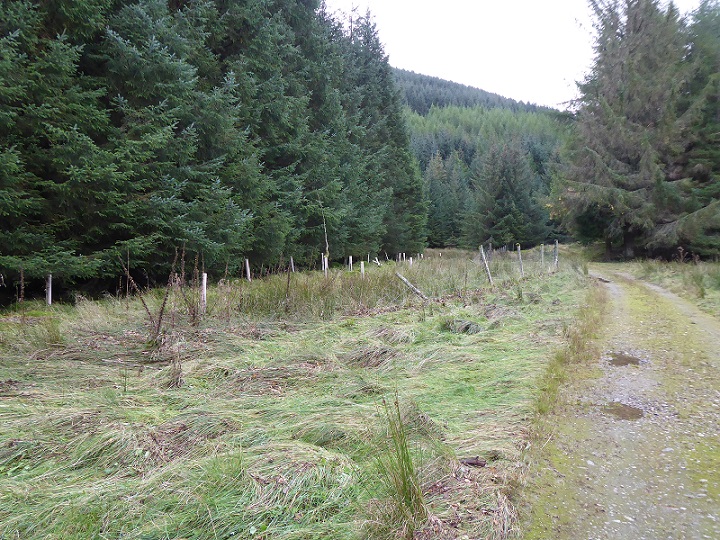
The lack of ANY self-seeded trees along the plantation edge in the photo suggests the fence only worked for a few years at most.
What then appears to have happened is that someone decided to try and soften the edge of the forest and/or improve the biodiversity by planting native trees in plastic tree tubes along the once “protected” strip.
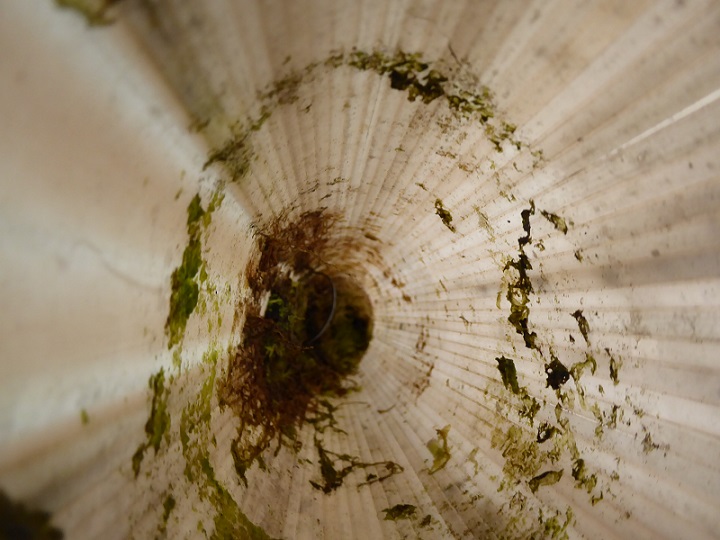
From a distance, I did not appreciate how old the tree tubes were and thought there might be saplings growing inside them. Closer inspection put me right. Whatever trees had been in the shelters had died.
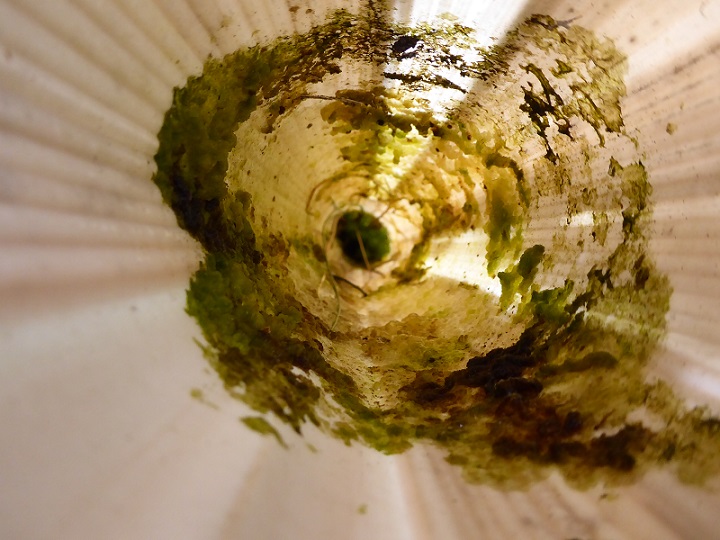 But I did not realise how old the shelters were or how completely they had failed until I spotted this dead tree protruding from one of them:
But I did not realise how old the shelters were or how completely they had failed until I spotted this dead tree protruding from one of them:
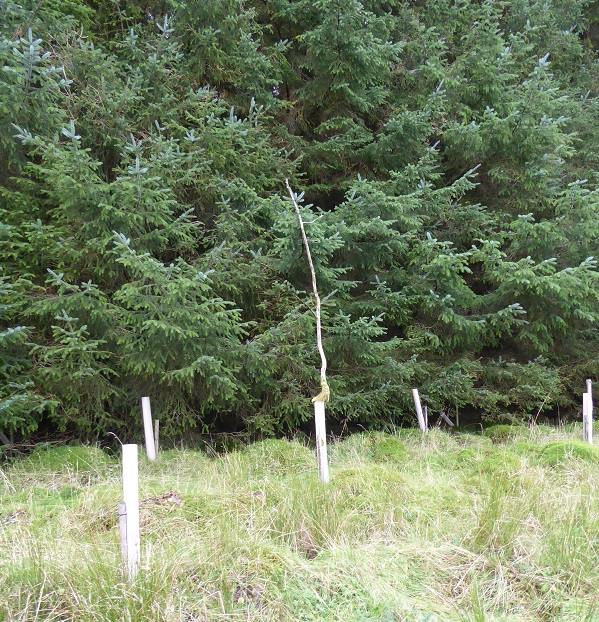
The reason why the tree tubes in this case have failed so completely is unclear – to me at least.
Since the failure of the fencing and the tree tubes no-one has cleared up. While Scottish Forestry, the government agency, dishes out large sums of money to landowners to install fencing and tree tubes, it does not require grant recipients to clear up forest industry junk afterwards. We are far from the “circular economy”. Indeed, Scotland’s forestry grants system forces most landowners and managers to use fences and plastic tree tubes since the award of grant is almost always dependent on the density of tree cover achieved within a planted area in the first few years. This forces land managers to plant lots of trees creating a tasty treat for herbivores, which then have to be protected by fences and tubes if the grant is not to be clawed back. A vicious circle, the opposite of what is needed.
The problems with the forestry grants system and their implications for rewilding are very clearly explained in “A Journey in Landscape Restoration; Carrifran Wildwood and Beyond” edited by Philip and Myrtle Ashmole for Borders Forest Trust (2020) which I was reading recently and would highly recommend.
Unlike most tree planters, Borders Forest Trust (BFT) are committed to the removal of all plastic tree tubes and fences where possible (scandalously they need a sheep fence along the boundary between Carrifran and the National Trust for Scotland’s property at Grey Mare’s Tail because of the number of sheep there). The book also explains just what hard work and how much volunteer time it takes to remove tree tubes. Most commercial foresters are unlikely ever to do that, the result being that the levels of plastic pollution in Scotland’s soils and water courses will inevitably increase overtime.
On the way up to Inverlochlarig I had stopped at the car park on Loch Lubnaig where I had previously criticised the Loch Lomond and Trossachs National Park Authority (LLTNPA)’s use of plastic tree tubes. I was pleased to see they have now all been removed – congratulations are due to whatever member of staff was responsible for this.
Unfortunately, the LLTNPA has failed to show an interest in the wider problems and indeed allowed itself to set a terrible example and get involved in planting trees in plastic tubes along the River Larig, The LLTNPA seems to have no appreciation of the effort that would be required to remove all the forestry junk from the National Park, let alone the will to tackle the source of the problem, the forestry grants systems and the high numbers of grazing animals which are preventing natural regeneration of woodland.

The forestry grant system should be scrapped. It is completely unnecessary today when every investor from Edinburgh to Singapore and beyond is trying to buy land in Scotland in order to plant trees for carbon offsetting purposes. There is absolutely no need any longer for the Scottish Government to continue wasting £millions of taxpayers money on tree planting schemes in the uplands – take a walk today onto BrewDog’s Kinrara estate near Aviemore to see all the damage being done by digging and fencing in preparation for planting, funded by forestry grant aid. Planting trees alongside existing natural regeneration on Kinrara is crazy when all that is needed is to control red deer grazing pressure. We need to stop wasting public money on tree planting and instead use the money to employ lots more deer stalkers across the whole of Scotland to reduce deer grazing pressure and allow natural vegetation recovery.
Sorry but I just can’t understand why all areas have to be covered in trees. In the pictures you post show a nice clear border letting in light along a road/path for people to enjoy without being totally closed in. Have a look at the self seeded trees along the Crianlarich bypass that will soon be a total enclosure at either side of the road. I have said before on your site that all this so called re-wilding in a lot of areas has caused a dramatic decline in native birds and flowering plants. A lot of the so called environmental people don’t live in these areas and do not see what is there and the requirements the local wildlife. Fence it , plant it and everything will be green and healthy. For years the land has healthy and mostly in stability. Sheep and deer serve there place in management of the land and should not be totally excluded.